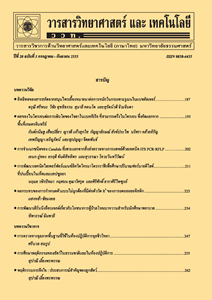องค์ประกอบบรรยากาศความปลอดภัยในการทำงานของพนักงานในสายการผลิตอุตสาหกรรมอาหาร จังหวัดสงขลา
Main Article Content
Abstract
Abstract
A cross-sectional descriptive study was described the safety climates’ structure. The safety climate was investigated in food manufacturing industry in Songkhla province during September, 2015 – August, 2016. The totally 1014 workers of production line were voluntary participated in this study. They were interviewed by using a NOSACQ-50-Thai questionnaire. Exploratory Factor Analysis was used to analyze the component of safety climate. The safety climate in food manufacturing were 5 components included: (1) commitment management and employee of safety, (2) participation empowerment and justice of safety, (3) awareness and risk management of employees, (4) safety activity, and (5) safety learning, communication and trust in the workplace. The difference of position and working experiences had significantly differences with the mean scores of safety climate. The leaders had significantly higher mean scores of safety climate than those workers. We concluded that there was 5 components of safety climate. Position and work experience factors were influence on the workers’ perception of safety climate.
Keywords: factor analysis; safety climate; occupational health; safety management
Article Details
References
[2] Eeckelaert, L., Starren, A., Scheppingen, A.V., Fox, D. and Brück, C., 2011, Occupational Safety and Health Culture Assessment: A Review of Main Approaches and Selected Tools, European Agency for Safety and Health at Work (EU-OSHA), Luxembourg.
[3] Kines, P., Lappalainen, J., Mikkelsen, K.L., Olsen, E., Pousette, A. and Tharaldsen, J., 2011, Nordic safety climate questionnaire (NOSACQ-50): A new tool for diagnosing occupational safety climate, Int. J. Ind. Ergon. 41: 634-646.
[4] สำนักงานกองทุนเงินทดแทน กระทรวงแรงงาน, สถิติการประสบอันตรายจากการทำงานในข่ายกองทุนเงินทดแทน, แหล่งที่มา : http://www. sso.go.th/wpr/category.jsp?lang=th&cat=801, 10 มิถุนายน 2558.
[5] สภาอุตสาหกรรมจังหวัด, 2558, แหล่งที่มา : http://www.ftiprovince.or.th/province/province.aspx?id=59& data=3, 10 มกราคม 2558.
[6] ฐิติวร ชูสง และธนิษฐา ศิริรักษ์, 2559, คู่มือการใช้แบบวัดบรรยากาศความปลอดภัย อาชีวอนามัย และสภาพแวดล้อมการทำงานของ NORDIC ฉบับภาษาไทย (NOSACQ-50-THAI), คณะแพทยศาสตร์ มหาวิทยาลัยสงขลานครินทร์, สงขลา.
[7] ปวีณา กวีกิจธรรมกุล, 2553, ปัจจัยที่มีอิทธิพลต่อวัฒนธรรมความปลอดภัยในงานก่อสร้าง, วิทยานิพนธ์ปริญญาโท, มหาวิทยาลัยเกษตร ศาสตร์, กรุงเทพฯ.
[8] สำนักงานมาตรฐานผลิตภัณฑ์อุตสาหกรรม, 2554, มาตรฐานผลิตภัณฑ์อุตสาหกรรม มอก. 18001 ระบบการจัดการอาชีวอนามัยและความปลอดภัย : ข้อกำหนด, สำนักงานมาตรฐานผลิตภัณฑ์อุตสาหกรรม กระทรวงอุตสาหกรรม, กรุงเทพฯ.
[9] Seo, D.C., Torabi, M.R., Blair, E.H. and Ellis, N.T., 2004, A cross-validation of safety climate scale using confirmatory factor analytic approach, J. Safety Res. 35: 427-445.
[10] Ghahramani, A. and Khalkhali, H.R., 2015, Development and validation of a safety climate scale for manufacturing industry, Saf. Health Work 6(2): 97-103.
[11] Zohor, D., 1980, Safety climate in industrial organizations: Theoretical and applied implications, J. Appl. Psychol. 65(1): 96-102.
[12] รัฐนนท์ ปานสมุทร์, 2557, ปัจจัยที่ส่งผลต่อบรรยากาศความปลอดภัยในงานก่อสร้างอาคาร, วิทยานิพนธ์ปริญญาโท, มหวิทยาลัยเกษตร ศาสตร์, กรุงเทพฯ.
[13] ชุติมา พันละม้าย, 2550, พฤติกรรมเสี่ยงต่อการเกิดอุบัติเหตุและปัจจัยที่เกี่ยวข้องในพนักงานอุตสาหกรรมอาหารทะเลบรรจุกระป๋อง, วิทยานิพนธ์ปริญญาโท, มหาวิทยาลัยเชียงใหม่, เชียงใหม่.
[14] สำนักงานกองทุนเงินทดแทน กระทรวงแรงงาน. สถิติการประสบอันตรายจากการทำงานในข่ายกองทุนเงินทดแทน, แหล่งที่มา : http://www.sso.go.th/wpr/category.jsp?lang=th&cat=801, 10 มิถุนายน 2558.
[15] อิศรัฎฐ์ ริไธสง, 2558, การวิเคราะห์ข้อมูลเชิงปริมาณขั้นสูงสำหรับการวิจัยทางพฤติกรรมศาสตร์, ภาควิชารัฐประศาสนศาสตร์ คณะวิทยาการจัดการ มหาวิทยาลัยสงขลานครินทร์, สงขลา.
[16] Yousef, Y., Jahangiri, M., Choobineh, A., Tabatabaei, H., Keshavarzi, S., Shams, A. and Mohammadi, Y., 2016, Validity assessment of the Persian version of the Nordic Safety Climate Questionnaire (NOSACQ-50): A case study in a Steel Company, Saf. Health Work 7(4): 326-330.
[17] Hofstede, G., 1998, Identifying organiza-tional subcultures: An empirical approach, J. Manag. Stud. 35(1): 1-12.
[18] Huanga, Y.H., Robertsona, M.M., Leea, J., Rineera, J., Murphya, L.A., Garabeta, A. and Dainoffa, M.J., 2014, Supervisory interpretation of safety climate versus employee safety climate perception: Association with safety behavior and outcomes for lone workers, Transport. Res. F: Traf. Psychol. Behav. 26: 348-360.
[19] Zohor, D., 2010, Thirty years of safety climate research: Reflections and future directions, Accident Anal. Prev. 65: 96-102.


